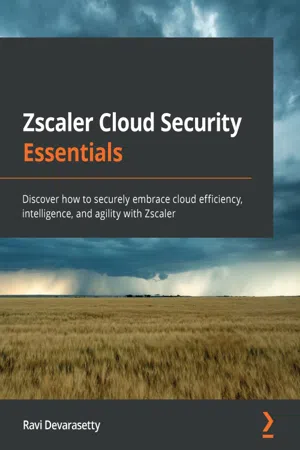
Zscaler Cloud Security Essentials
Ravi Devarasetty
- 236 pages
- English
- ePUB (mobile friendly)
- Available on iOS & Android
Zscaler Cloud Security Essentials
Ravi Devarasetty
About This Book
Harness the capabilities of Zscaler to deliver a secure, cloud-based, scalable web proxy and provide a zero-trust network access solution for private enterprise application access to end usersKey Features• Get up to speed with Zscaler without the need for expensive training• Implement Zscaler Internet Access (ZIA) and Zscaler Private Access (ZPA) security solutions with real-world deployments• Find out how to choose the right options and features to architect a customized solution with ZscalerBook DescriptionMany organizations are moving away from on-premises solutions to simplify administration and reduce expensive hardware upgrades. This book uses real-world examples of deployments to help you explore Zscaler, an information security platform that offers cloud-based security for both web traffic and private enterprise applications. You'll start by understanding how Zscaler was born in the cloud, how it evolved into a mature product, and how it continues to do so with the addition of sophisticated features that are necessary to stay ahead in today's corporate environment. The book then covers Zscaler Internet Access and Zscaler Private Access architectures in detail, before moving on to show you how to map future security requirements to ZIA features and transition your business applications to ZPA. As you make progress, you'll get to grips with all the essential features needed to architect a customized security solution and support it. Finally, you'll find out how to troubleshoot the newly implemented ZIA and ZPA solutions and make them work efficiently for your enterprise. By the end of this Zscaler book, you'll have developed the skills to design, deploy, implement, and support a customized Zscaler security solution. What you will learn• Understand the need for Zscaler in the modern enterprise• Study the fundamental architecture of the Zscaler cloud• Get to grips with the essential features of ZIA and ZPA• Find out how to architect a Zscaler solution• Discover best practices for deploying and implementing Zscaler solutions• Familiarize yourself with the tasks involved in the operational maintenance of the Zscaler solutionWho this book is forThis book is for security engineers, security architects, security managers, and security operations specialists who may be involved in transitioning to or from Zscaler or want to learn about deployment, implementation, and support of a Zscaler solution. Anyone looking to step into the ever-expanding world of zero-trust network access using the Zscaler solution will also find this book useful.
Frequently asked questions
Information
Section 1: Zscaler for Modern Enterprise Internet Security
- Chapter 1, Security for the Modern Enterprise with Zscaler
- Chapter 2, Understanding the Modular Zscaler Architecture
- Chapter 3, Delving into ZIA Policy Features
- Chapter 4, Understanding Traffic Forwarding and User Authentication Options
- Chapter 5, Architecting and Implementing Your ZIA Solution
- Chapter 6, Troubleshooting and Optimizing Your ZIA Solution
Chapter 1: Security for the Modern Enterprise with Zscaler
- There are no upgrade cycles for the enterprise as Zscaler takes care of that.
- There is a shift from CAPEX to OPEX, which enterprises like because of predictability.
- An amazing user experience as users can access applications using the best path.
- Fundamental definitions in security
- Shift of the modern enterprise and its workforce
- The need for scalable, cloud-based security
- Zscaler Internet Access (ZIA) for a safe and secure internet experience
- Zscaler Private Access (ZPA) for a zero-trust private application access
Fundamental definitions in security
Active Directory
Authentication
Bad actors
- Attacking legitimate users and businesses due to various motivations
- Stealing sensitive and valuable information from individuals and businesses
- Compromising infrastructure such as servers and using them for their needs